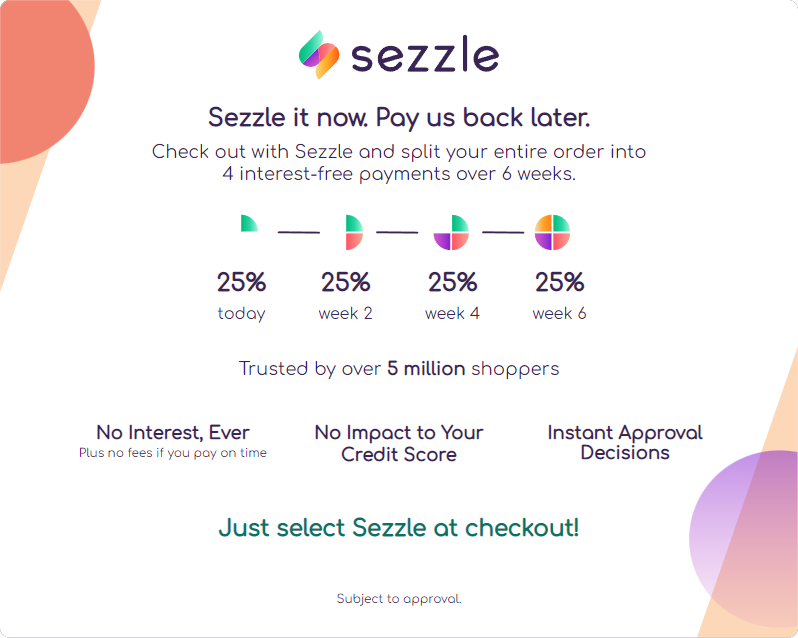



We provide a 24-month warranty on all of our products.

We take immense pride in our products and know you're going to love them as much as we do. If you're not 10/10 obsessed, let us know within 30 days for our 100% money back guarantee.

 ✕
✕
Check out with Sezzle and split your entire order into 4 interest-free payments over 6 weeks.
On all orders $90USD+ we offer free 2-7 business day standard shipping in the US + CA and 11-20 business day shipping in the UK.
Unfortunately we are unable to make deliveries to PO boxes, APO/FPO, or US military bases outside the US.

 Taylor LED Compact Mirror
Taylor LED Compact Mirror
 Vera Vanity with 10x Lara Mirror
Vera Vanity with 10x Lara Mirror
 Rivo Nano Ionic Facial Steamer
Rivo Nano Ionic Facial Steamer
 Abigail LED Travel Mirror
Abigail LED Travel Mirror
 Mini Taylor LED Compact Mirror
Mini Taylor LED Compact Mirror
 Ultimate Mirror Bundle
Ultimate Mirror Bundle
 Abigail 10x Travel Mirror
Abigail 10x Travel Mirror
 Mila 2 Luxe LED Compact Mirror
Mila 2 Luxe LED Compact Mirror
 Tru-Glow Lighted Mirrors Duo
Tru-Glow Lighted Mirrors Duo
 Clara Microdermabrasion Device
Clara Microdermabrasion Device
 Jingle and Glow Kit
Jingle and Glow Kit
 Cali Electric Callus Remover
Cali Electric Callus Remover
 Isla Facial Cleansing Brush
Isla Facial Cleansing Brush
 Madison Makeup Case
Madison Makeup Case
 The Glow Getter Ritual Set
The Glow Getter Ritual Set
 Mila 2 LED Compact Mirror
Mila 2 LED Compact Mirror
 Madeline Mini Hollywood Mirror
Madeline Mini Hollywood Mirror
 Mini Taylor LED Compact Mirror | Romantic Florals
Mini Taylor LED Compact Mirror | Romantic Florals
 Vera Lighted Vanity Mirror
Vera Lighted Vanity Mirror
 Lana 10x Magnifying Mirror
Lana 10x Magnifying Mirror
 Juni 2 Lighted Car Visor Mirror
Juni 2 Lighted Car Visor Mirror
 Taylor LED Compact Mirror | Cheetah Chic
Taylor LED Compact Mirror | Cheetah Chic
 Mini Taylor LED Compact Mirror | Cosmic Leopard
Mini Taylor LED Compact Mirror | Cosmic Leopard
 Soft & Smooth Body Kit
Soft & Smooth Body Kit
 Cami Lighted Handheld Mirror
Cami Lighted Handheld Mirror
 Pore-Parazzi Set
Pore-Parazzi Set
 2 Be Lit Mirror Duo
2 Be Lit Mirror Duo
 Aria Pro Makeup Brush Set
Aria Pro Makeup Brush Set
 Love at First Light Mirror Set
Love at First Light Mirror Set
 Daily Essentials Skincare Kit
Daily Essentials Skincare Kit
 Taylor LED Compact Mirror | Blush Zebra
Taylor LED Compact Mirror | Blush Zebra
 Glowing Places Kit
Glowing Places Kit
 Mini Taylor LED Compact Mirror | Cheetah Chic
Mini Taylor LED Compact Mirror | Cheetah Chic
 Mini Taylor LED Compact Mirror | Blush Zebra
Mini Taylor LED Compact Mirror | Blush Zebra
 Monroe Hollywood Vanity Mirror
Monroe Hollywood Vanity Mirror
 Mira 2 Magnifying Mirror 10x
Mira 2 Magnifying Mirror 10x
 Farah Makeup Remover Set
Farah Makeup Remover Set
 Remi Uplift Facial Massage Roller
Remi Uplift Facial Massage Roller
 Macy Makeup Bag
Macy Makeup Bag
 Avery Spa Headband Set
Avery Spa Headband Set
 Harper Makeup Sponge Set
Harper Makeup Sponge Set
 Tara 10x Magnifying Mirror
Tara 10x Magnifying Mirror
 Leather Pouch for Compact Mirror
Leather Pouch for Compact Mirror
 Tasha Heated Eyelash Curler
Tasha Heated Eyelash Curler
 Charlotte Scalp Massager
Charlotte Scalp Massager
 Lara 10x Magnifying Mirror for Vera
Lara 10x Magnifying Mirror for Vera
 Zoe Drying Pads
Zoe Drying Pads
 Traveling Twosome
Traveling Twosome
 Tala Gooseneck Attachment for Mira
Tala Gooseneck Attachment for Mira
![Gift Card [USD]](http://fancii.com/cdn/shop/products/fancii-gift-card_45x.gif?v=1762198925) Gift Card [USD]
Gift Card [USD]
![Gift Card [CAD]](http://fancii.com/cdn/shop/products/fancii-gift-card_8caf3995-16f8-44ab-90b2-3aa4b3050424_45x.gif?v=1762269131) Gift Card [CAD]
Gift Card [CAD]
![Gift Card [GBP]](http://fancii.com/cdn/shop/products/fancii-gift-card_bda6bc27-1ef2-4efb-bf94-e3f8882f7d97_45x.gif?v=1762269131) Gift Card [GBP]
Gift Card [GBP]
 Cora 3 Facial Cleansing Brush
Cora 3 Facial Cleansing Brush
 Elle Satin Scrunchie
Elle Satin Scrunchie
 Mini Taylor LED Compact Mirror | Meadow
Mini Taylor LED Compact Mirror | Meadow
 Mini Taylor LED Compact Mirror | Mediterranean Coast
Mini Taylor LED Compact Mirror | Mediterranean Coast
 Glowcation Station
Glowcation Station
 Taylor LED Compact Mirror | Cosmic Leopard
Taylor LED Compact Mirror | Cosmic Leopard

If you’re one of the more than 3 million Americans over the age of 40 who suffer from low vision, you already know how difficult it can be to deal with compromised sight. Even if your vision impairment is the natural result of aging, the last thing you want to worry about is buying a magnifying aid, only to discover that it doesn’t live up to its promises.
When purchasing a magnifier, there are three important points you should keep in mind to avoid choosing the wrong one, and to prevent the possibility of falling victim to the exaggerated, and often blatantly false claims, that are made by many magnifying glass companies.
A higher magnification is not always superior to a lower magnification
A larger lens is not always better than a smaller lens
Many magnifiers actually provide far lower magnifications than they claim
As a group, these factors revolve around one crucial optical rule: the bigger the magnifying lens, the smaller the magnification.
One of the most common mistakes made by consumers when shopping for a magnifying glass is to assume that the higher its power, the more effective a tool it will be. This is not always the case however, especially where an activity like reading is concerned.
A magnifier is a clear, convex lens that causes light rays to bend and converge, and objects to appear larger than they are as a result. For example:
a 2X magnifying glass makes items look twice as big as they are
a 20X jeweler’s loupe magnifier makes those same items look 20 times as big as they are
But because of the physics surrounding light rays and the curvature of the convex lens, the 20X magnifier has to be significantly smaller than the 2X magnifying lens in order to work effectively. This means that it’s only capable of focusing on a relatively small viewing area.
You wouldn’t make much reading progress moving across the printed page of your favorite book or newspaper with a high-powered magnifying lens, since you’d typically only be able to view a few letters at a time.
The other common assumption about magnifiers is that a bigger lens is more versatile, and therefore represents a more worthwhile purchase. After all, a larger magnifying glass allows you to see more of what you’re looking at, and is often easier and more convenient to handle. But while bigger is often better in the case of something like a reading magnifier, since it means you can scan a whole page or paragraph at once, a larger lens also requires a sacrifice in magnification.
The laws of optics tell us:
the higher the power, the smaller the magnifying lens must be
the bigger the magnifying glass, the lower its magnification
In the world of low-cost magnifiers, a lens with a width of 4 inches will always have a lower magnification than one that’s only 1 inch across. A large magnifying glass simply cannot pull double duty as a jeweler’s loupe, or any other type of high-power, fine-detail magnifier.
Many magnifying glasses sold today are not at all what they claim to be. Fortunately, once you understand the relationship between a magnifier’s size and its power, you’re far less likely to be fooled by unethical companies making unrealistic promises about their magnifying aids.
Remember that it’s not physically possible to produce a magnifying glass that’s a single lens, lightweight, inexpensive, and that incorporates both:
a wide field of view, and
a high power of magnification
While the most commonly seen false claims involve declarations of 5X and 10X magnification, for lenses that actually offer no more than 2X or 3X power, there are many examples of far more exaggerated statements in the market today. You won’t have to look far in fact, to find inexpensive products that claim to offer 20X, or even 30X magnification, with lenses that are as large as 4 - 6 inches across.
The best way to avoid being taken advantage of when buying a magnifying glass is to use your common sense, and to limit your dealings to reputable companies. It may sound cliché, but if you run across a magnifier that appears to be claiming an inflated magnification for its size, remember that some things simply are too good to be true.
Customer Commentsnot an expert here, but sure sounds like it should be removed. Maybe pull a little on an edge & see if it comes off readily. Either that or you’ve got a blurry magnifier.
sometimes a film cover is used to keep the glass clean until you use it.
Recently bought a Fancii Magnifying Glass and it has a Film cover on both sides and it makes vison Blurry! Should this be removed?
On June 22, 2021